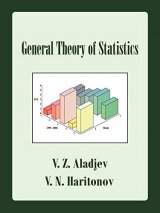General Theory of Statistics
The book is a statistical course for undergraduate students in all fields of social and economic sciences. The book presents a manual on the course "General Theory of Statistics", including a series of not quite traditional topics. First of all, it concerns the mathematical bases of statistics and use of computer technologies in statistical probing. Thematic choice of the chapters and sections of the book is caused not only by interests and tastes of the authors, but also by modern tendencies in applied statistics and orientation of the given work. The book is based on a course of lectures given by the first author for undergraduates in social and economic sciences along with three books published in Russian and English in Estonia, Lithuania and Byelorussia. This book has been written for a large enough audience of teachers, researchers, statisticians, students, collegians and users of statistics in behavioral and social sciences. Above all, the book is directed to a wide cir
From the Authors Preface Chapter 1. Subject and method of statistical science 1.1. Subject of statistics, and its place in the system of sciences 1.2. Brief excursus into history of statistics 1.3. General organization principles of state statistical service 1.4. Statistics problems and characteristic features of its methodology 1.5. The primary concepts and categories of statistics Chapter 2. Elements of the probability theory 2.1. Classic concepts of probability, and combinatorial calculus 2.2. Random variables and their distribution laws 2.3. Characteristics of probabilistic distributions 2.4. Fundamental laws of probability distribution 2.5. Basic testing distributions Chapter 3. Fundamentals of statistical observation 3.1. Program and plan of statistical observation 3.2. Basic forms, kinds and methods of statistical observation 3.3. Questions of accuracy of statistical observations 3.4. Verification of outcomes of statistical observation 3.5. Special questions of statistical accounting 3.6. Data, used for illustration of the present book material Chapter 4. Grouping, consolidated return and data presentation 4.1. Problems and contents of consolidated return 4.2. Basics of the groupings method 4.3. Interval groupings and classifications 4.4. Tabular representation of statistical data 4.5. Statistical series of distribution 4.6. Graphical representation of statistical data Chapter 5. Absolute and relative statistical quantities 5.1. Absolute statistical quantities 5.2. Relative statistical quantities Chapter 6. Basics of averages method 6.1. Properties of arithmetical average 6.2. Other types of averages, and their choice 6.3. Structural averages of populations 6.4. The averages method – one of the most important technique and methodology of the generalization Chapter 7. Elements of analysis of variational series 7.1. Variation of showings population 7.2. Variation evaluation of the grouped population data 7.3. Elements of form analysis of distribution curves 7.4. Elements of the sampling method theory 7.5. Testing of statistical hypotheses 7.6. Elements of correlation and regression analysis Chapter 8. Elements of time series analysis 8.1. Time series types, their construction and presentation 8.2. Statistical showings of time series 8.3. Average showings of time series 8.4. Determination of basic tendency (trend) of time series 8.5. Analysis of casual constituent of time series 8.6. Probing of periodical oscillations of time series 8.7. Comparative and connected analysis of time series Chapter 9. Elements of the index method 9.1. Concept of the indexes, their types and purpose 9.2. Aggregative and individual indexes 9.3. Average indexes, basic and chain indexes 9.4. Fundamental economical indexes and their interrelation 9.5. Logical criteria of good indexes Chapter 10. Computer means of statistical data analysis 10.1. Basic prerequisites of usage of computers in statistics 10.2. A brief survey of statistical software 10.3. Usage of the class of PCs in statistical data analysis 10.4. A brief characteristic of computer mathematics systems Maple and Mathematica 10.5. Elements of statistical data analysis in Maple system 10.5.1. Tools for problems solving of descriptive statistics 10.5.2. Tools for problems solving of regression analysis 10.5.3. Tools for testing of statistical hypotheses 10.5.4. Elements for simple analysis of time series References List of Principal Abbreviations About the Authors
Translation
Translate and read this book in other languages:
Select another language:
- - Select -
- 简体中文 (Chinese - Simplified)
- 繁體中文 (Chinese - Traditional)
- Español (Spanish)
- Esperanto (Esperanto)
- 日本語 (Japanese)
- Português (Portuguese)
- Deutsch (German)
- العربية (Arabic)
- Français (French)
- Русский (Russian)
- ಕನ್ನಡ (Kannada)
- 한국어 (Korean)
- עברית (Hebrew)
- Gaeilge (Irish)
- Українська (Ukrainian)
- اردو (Urdu)
- Magyar (Hungarian)
- मानक हिन्दी (Hindi)
- Indonesia (Indonesian)
- Italiano (Italian)
- தமிழ் (Tamil)
- Türkçe (Turkish)
- తెలుగు (Telugu)
- ภาษาไทย (Thai)
- Tiếng Việt (Vietnamese)
- Čeština (Czech)
- Polski (Polish)
- Bahasa Indonesia (Indonesian)
- Românește (Romanian)
- Nederlands (Dutch)
- Ελληνικά (Greek)
- Latinum (Latin)
- Svenska (Swedish)
- Dansk (Danish)
- Suomi (Finnish)
- فارسی (Persian)
- ייִדיש (Yiddish)
- հայերեն (Armenian)
- Norsk (Norwegian)
- English (English)
Citation
Use the citation below to add this book to your bibliography:
Style:MLAChicagoAPA
"General Theory of Statistics Books." Literature.com. STANDS4 LLC, 2025. Web. 22 Feb. 2025. <https://www.literature.com/book/general_theory_of_statistics_1762>.








Discuss this General Theory of Statistics book with the community:
Report Comment
We're doing our best to make sure our content is useful, accurate and safe.
If by any chance you spot an inappropriate comment while navigating through our website please use this form to let us know, and we'll take care of it shortly.
Attachment
You need to be logged in to favorite.
Log In